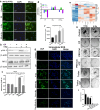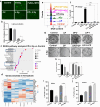Clobetasol propionate, a Nrf-2 inhibitor, sensitizes human lung cancer cells to radiation-induced killing via mitochondrial ROS-dependent ferroptosis
- PMID: 38480835
- PMCID: PMC11192725
- DOI: 10.1038/s41401-024-01233-8
Clobetasol propionate, a Nrf-2 inhibitor, sensitizes human lung cancer cells to radiation-induced killing via mitochondrial ROS-dependent ferroptosis
Abstract
Combining radiotherapy with Nrf-2 inhibitor holds promise as a potential therapeutic strategy for radioresistant lung cancer. Here, the radiosensitizing efficacy of a synthetic glucocorticoid clobetasol propionate (CP) in A549 human lung cancer cells was evaluated. CP exhibited potent radiosensitization in lung cancer cells via inhibition of Nrf-2 pathway, leading to elevation of oxidative stress. Transcriptomic studies revealed significant modulation of pathways related to ferroptosis, fatty acid and glutathione metabolism. Consistent with these findings, CP treatment followed by radiation exposure showed characteristic features of ferroptosis in terms of mitochondrial swelling, rupture and loss of cristae. Ferroptosis is a form of regulated cell death triggered by iron-dependent ROS accumulation and lipid peroxidation. In combination with radiation, CP showed enhanced iron release, mitochondrial ROS, and lipid peroxidation, indicating ferroptosis induction. Further, iron chelation, inhibition of lipid peroxidation or scavenging mitochondrial ROS prevented CP-mediated radiosensitization. Nrf-2 negatively regulates ferroptosis through upregulation of antioxidant defense and iron homeostasis. Interestingly, Nrf-2 overexpressing A549 cells were refractory to CP-mediated ferroptosis induction and radiosensitization. Thus, this study identified anti-psoriatic drug clobetasol propionate can be repurposed as a promising radiosensitizer for Keap-1 mutant lung cancers.
Keywords: clobetasol propionate; glucocorticoid; iron homeostasis; lipid peroxidation; non-small cell lung carcinoma; radiosensitization.
© 2024. The Author(s), under exclusive licence to Shanghai Institute of Materia Medica, Chinese Academy of Sciences and Chinese Pharmacological Society.
Conflict of interest statement
The authors declare no competing interests.
Figures








References
-
- Aravindan N, Aravindan S, Pandian V, Khan FH, Ramraj SK, Natt P, et al. Acquired tumor cell radiation resistance at the treatment site is mediated through radiation-orchestrated intercellular communication. Int J Radiat Oncol Biol Phys. 2014;88:677–85. doi: 10.1016/j.ijrobp.2013.11.215. - DOI - PMC - PubMed
MeSH terms
Substances
LinkOut - more resources
Full Text Sources
Medical
Miscellaneous

